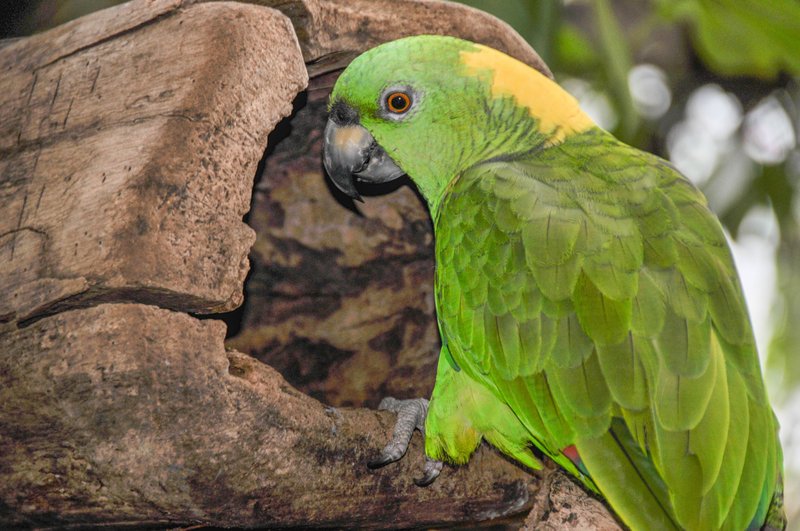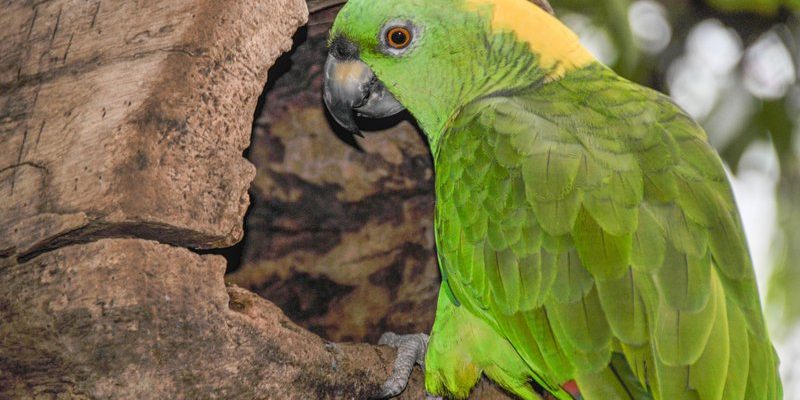
When thinking about Amazon parrots, picture a range of dazzling greens, yellows, and blues. They’re known for their friendly nature and can even mimic human speech. If you’re planning a trip to places like the Amazon Rainforest or Central America, you might want to keep an eye—and ear—out for these feathered friends. By understanding their appearance, calls, and behaviors, you’ll be able to spot them effortlessly. Ready to learn how to identify an Amazon parrot? Let’s get started!
Physical Characteristics of Amazon Parrots
To spot an Amazon parrot, you’ll want to start with its striking colors. Most Amazon parrots boast vibrant green feathers, often adorned with splashes of yellow and blue or even a dash of red. This colorful plumage helps them camouflage in the dense foliage of their tropical habitat, but it also makes them quite the sight when they’re flying or perched in the trees. Some species even have distinctive markings on their faces and wings that can help you tell them apart.
One thing to note is their size. Amazon parrots typically range from 10 to 18 inches long, depending on the species. They have sturdy bodies, a strong beak, and a short, square tail. Their beaks are perfect for cracking seeds and nuts, allowing them to thrive in their natural environments. When you see a bigger parrot-like bird, chances are it could be an Amazon!
Another key feature is their eyes, which are usually bright and expressive, often surrounded by a patch of bare skin. This adds to their charming appearance and makes it easier to spot them when they’re gazing around their surroundings. So, keep your eyes peeled for those bright eyes and colorful feathers!
Behavior and Habitats
Recognizing Amazon parrots isn’t just about their looks; their behavior plays a significant role, too. These birds are social creatures, often found in small flocks. You might see them flying together or perched close to one another, squawking and playing, which creates a lively atmosphere in the jungle. Honestly, their playful antics can be quite entertaining if you’re lucky enough to catch a glimpse.
They tend to hang out in forested areas, including rainforests, woodlands, and even mangroves. While they prefer high altitudes in the trees, you might also spot them coming down to the ground to forage. They love munching on seeds, fruits, and nuts, so if you’re hiking and come across a pile of fruit remnants, keep an eye out; they might not be far!
Another interesting behavior is their vocalization. You might be wondering how to tell them apart from other parrots or birds. Amazon parrots have a distinctive, loud squawk. Their calls can vary based on species, with some sounding like a raucous laugh or even human speech. If you hear loud, cheerful noises in the distance, it might just be a group of these colorful birds having a chat!
Listening for the Amazon Parrot’s Call
One of the best ways to identify an Amazon parrot in the wild is by tuning into their calls. Each species has its unique sound, and if you learn a few of these vocalizations, you can pinpoint their presence even when they’re hidden in the trees. The calls can be high-pitched and repetitive, making them quite distinct from other birds.
For example, the Double Yellow-Headed Amazon has a distinctive, loud squawking sound that can carry over long distances. If you’re in an area where these birds are known to live, keep your ears open for that unmistakable sound. It’s like their way of saying, “Hey, look at me!”
Using their vocalizations as clues can be a game-changer. Think of it as a birdwatcher’s treasure map. When you hear their calls, they’re probably nearby. You might even catch them mid-conversation as they communicate with their flock, adding a delightful soundtrack to your day in the wild.
Spotting Unique Markings
Different species of Amazon parrots have unique markings that help with identification. While the general coloration might be similar, small details can make all the difference. For instance, the Yellow-Naped Amazon is known for its striking yellow patch on the back of its head. Once you recognize these subtle differences, you’ll become a pro at identifying them in no time.
Another unique feature is their beaks. The beak shape can vary among species—from stout and robust to slightly curved. For instance, the Blue-Fronted Amazon has a slightly more curved beak, which contrasts with the stout beak of the more round-faced Red-Lored Amazon. Noticing these small distinctions can give you the edge when trying to figure out which Amazon parrot you’re looking at.
If you happen to spot an Amazon parrot, take a moment to observe its markings and personality traits. Each bird has its own quirks that add to their charm. This not only helps with identification but also deepens your appreciation for these intelligent creatures.
Different Species of Amazon Parrots
There are multiple species of Amazon parrots, each with its unique traits. Here are a few to watch for:
- Yellow-Headed Amazon: Distinguished by its bright yellow head and vocal abilities.
- Blue-Fronted Amazon: Known for its vivid blue forehead and friendly demeanor.
- Red-Lored Amazon: Easily recognized by the red patches on its cheeks and forehead.
- Double Yellow-Headed Amazon: Features yellow markings on both the head and neck, often quite vocal.
Each of these species inhabits a range of environments, so knowing where you might find them can enhance your birdwatching experience. By recognizing their specific characteristics and behaviors, you’ll feel more connected to their natural habitat and understand the beauty of these charming parrots.
Using Binoculars for Better Spotting
If you’re serious about spotting Amazon parrots in the wild, a good pair of binoculars can be a game changer. It’s like having front-row seats to a show that many people miss! With binoculars, you can watch them from a distance without disturbing their natural behaviors, making it easier to observe their stunning colors and lively interactions.
When using binoculars, here’s a tip: try to focus on high branches or the edges of the treetops. Parrots often prefer to perch in these areas where they can keep an eye out for predators. Just be patient, and don’t rush the process. You might have to wait a little while for them to show up, but when they do, it’s well worth it!
Remember to adjust the zoom and focus settings on your binoculars to get the clearest view. It can take time to get used to adjusting and spotting birds in motion, but with practice, you’ll start to feel like a seasoned birdwatcher!
Respecting Their Habitat
While spotting Amazon parrots can be thrilling, it’s crucial to remember to respect their environment. These birds thrive in their natural habitats, and it’s important to leave no trace when you’re out exploring. Stick to established trails, avoid disturbing nests, and don’t engage in loud noises that could scare them away.
By being mindful of their space, you’re not just protecting the parrots, but you’re also helping preserve their habitat for future generations. It’s a win-win situation where both you and the wildlife benefit. Think of yourself as a visitor in their home—one that gets to appreciate their beauty without disrupting their lives.
Remember that sustainable birdwatching can make a difference. If you love these vibrant creatures, supporting conservation efforts helps ensure that they’ll continue to grace the forests of South America for years to come.
In conclusion, identifying an Amazon parrot in the wild is all about paying attention to their physical traits, behaviors, and sounds. With a little patience and a keen eye, you’ll be able to spot these gorgeous birds during your adventures. Embrace the thrill of birdwatching and take pride in your newfound skills. Happy spotting!

